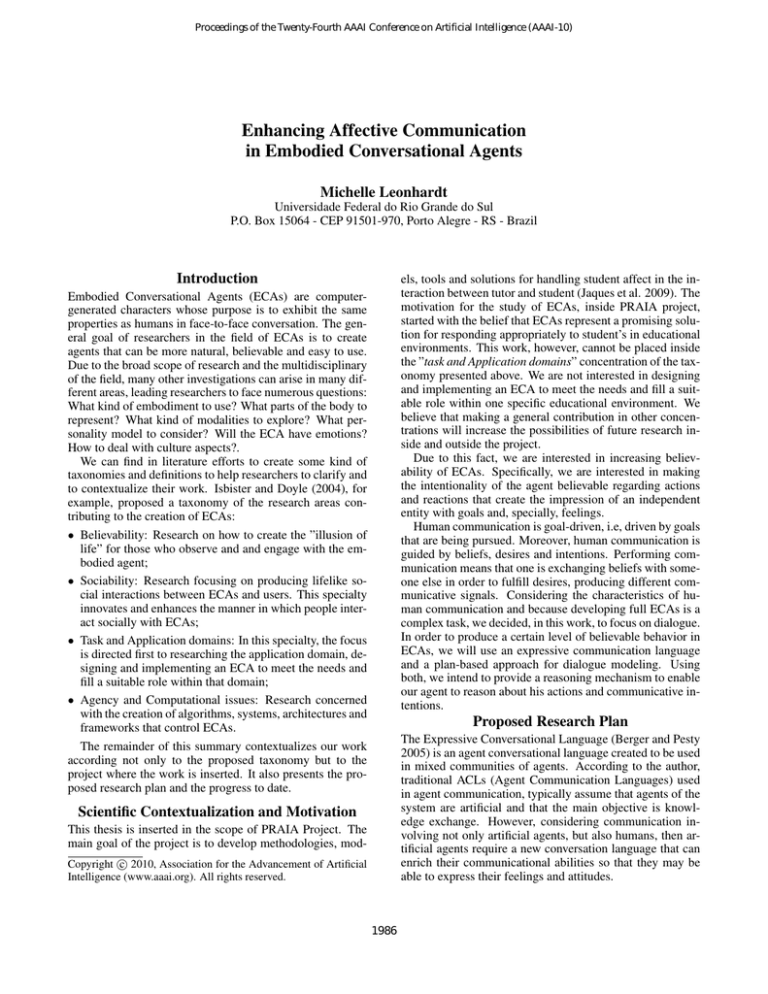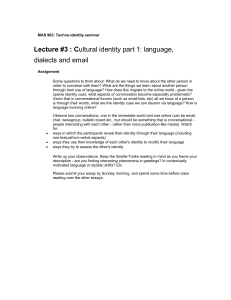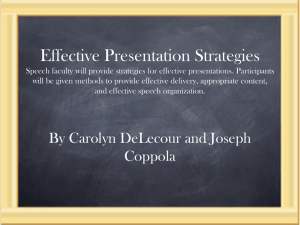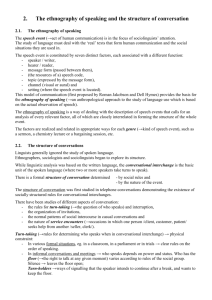
Proceedings of the Twenty-Fourth AAAI Conference on Artificial Intelligence (AAAI-10)
Enhancing Affective Communication
in Embodied Conversational Agents
Michelle Leonhardt
Universidade Federal do Rio Grande do Sul
P.O. Box 15064 - CEP 91501-970, Porto Alegre - RS - Brazil
Introduction
els, tools and solutions for handling student affect in the interaction between tutor and student (Jaques et al. 2009). The
motivation for the study of ECAs, inside PRAIA project,
started with the belief that ECAs represent a promising solution for responding appropriately to student’s in educational
environments. This work, however, cannot be placed inside
the ”task and Application domains” concentration of the taxonomy presented above. We are not interested in designing
and implementing an ECA to meet the needs and fill a suitable role within one specific educational environment. We
believe that making a general contribution in other concentrations will increase the possibilities of future research inside and outside the project.
Due to this fact, we are interested in increasing believability of ECAs. Specifically, we are interested in making
the intentionality of the agent believable regarding actions
and reactions that create the impression of an independent
entity with goals and, specially, feelings.
Human communication is goal-driven, i.e, driven by goals
that are being pursued. Moreover, human communication is
guided by beliefs, desires and intentions. Performing communication means that one is exchanging beliefs with someone else in order to fulfill desires, producing different communicative signals. Considering the characteristics of human communication and because developing full ECAs is a
complex task, we decided, in this work, to focus on dialogue.
In order to produce a certain level of believable behavior in
ECAs, we will use an expressive communication language
and a plan-based approach for dialogue modeling. Using
both, we intend to provide a reasoning mechanism to enable
our agent to reason about his actions and communicative intentions.
Embodied Conversational Agents (ECAs) are computergenerated characters whose purpose is to exhibit the same
properties as humans in face-to-face conversation. The general goal of researchers in the field of ECAs is to create
agents that can be more natural, believable and easy to use.
Due to the broad scope of research and the multidisciplinary
of the field, many other investigations can arise in many different areas, leading researchers to face numerous questions:
What kind of embodiment to use? What parts of the body to
represent? What kind of modalities to explore? What personality model to consider? Will the ECA have emotions?
How to deal with culture aspects?.
We can find in literature efforts to create some kind of
taxonomies and definitions to help researchers to clarify and
to contextualize their work. Isbister and Doyle (2004), for
example, proposed a taxonomy of the research areas contributing to the creation of ECAs:
• Believability: Research on how to create the ”illusion of
life” for those who observe and and engage with the embodied agent;
• Sociability: Research focusing on producing lifelike social interactions between ECAs and users. This specialty
innovates and enhances the manner in which people interact socially with ECAs;
• Task and Application domains: In this specialty, the focus
is directed first to researching the application domain, designing and implementing an ECA to meet the needs and
fill a suitable role within that domain;
• Agency and Computational issues: Research concerned
with the creation of algorithms, systems, architectures and
frameworks that control ECAs.
Proposed Research Plan
The Expressive Conversational Language (Berger and Pesty
2005) is an agent conversational language created to be used
in mixed communities of agents. According to the author,
traditional ACLs (Agent Communication Languages) used
in agent communication, typically assume that agents of the
system are artificial and that the main objective is knowledge exchange. However, considering communication involving not only artificial agents, but also humans, then artificial agents require a new conversation language that can
enrich their communicational abilities so that they may be
able to express their feelings and attitudes.
The remainder of this summary contextualizes our work
according not only to the proposed taxonomy but to the
project where the work is inserted. It also presents the proposed research plan and the progress to date.
Scientific Contextualization and Motivation
This thesis is inserted in the scope of PRAIA Project. The
main goal of the project is to develop methodologies, modc 2010, Association for the Advancement of Artificial
Copyright Intelligence (www.aaai.org). All rights reserved.
1986
asking questions that would not be familiar to the agent; (ii)
decide to address a different point of conversation that the
agent would not be ready to deal with.
Two options were considered to deal with this issue: unlimited possibilities of writing input sentences and restricted
input possibilities. The first option represented a great complexity because of the limitations on the state-of-the art on
NLP as well as because of our focus. On the other hand,
the second option seemed to have the complexity reduced,
but there was a question to be answered: ”What kind of restricted input to use and how to deal with it?”.
To answer the question, we decided to define possible sentences that could fit inside each conversational act. However,
because one sentence could represent more than one speech
act, we decided to work towards adapting this input solution in a way that the results would fit better the speech acts
and would have more scientific background. Using WordNet (http://wordnet.princeton.edu/), we performed a search
for all different verbs and expressions related to each act.
After selection of verbs and words, we defined a group of
sentences with different possibilities of expressing strength
in conversation.
Currently, we started developing the dialogue mechanism
of the agent and we are studying the relation of the personality characteristics in multimodalities of communication. Another direction of research at the moment is dedicated to the
output. For the verbal channel output we are strongly considering working with language alignment which consists
of adapting linguistic style of a virtual agent to the level of
specific characteristics detected in human utterances (politeness, formality, emotional state). We believe that language
alignment will provide different ways for the agent to express affective behavior.
Thirty three expressive conversation acts are formally defined, from the basic acts like inform and request to more
expressive ones like thank, apologize, congratulate, among
others. The expressive conversational language was developed considering the fact that communication is goal-driven.
The intention is to enable artificial agents within a mixed
community to function in a more advanced way that corresponds to the philosophical, psychological and linguistic realities of communication. The conversation acts are defined
with their success and satisfaction conditions and explicitly
introduce elements from the conversational background.
Plan-Based models of dialogue treat conversations as a sequence of actions to be planned, seeking to consider user’s
intentions and plans. The BDI model (Rao and Georgeff
1991) is one of the most known cognitive agent architectures. Agents in this model have three mental states: beliefs,
desires, and intentions.
Combining the Expressive Conversational Language and
the BDI model, we intend to increase believability in dialogue. In order to do so, we are considering a scenario where
two participants must collaborate in order to define the characteristics of an ECA. Initially, the role of the agent is to
guide the user while deciding the appearance and personality of an agent. As far as the conversation goes and participants start to decide on aspects of the agent personality, the
agent will react according to its characteristics (by means of
language expression and other multimodalities of communication).
The general methodology for the development of this thesis includes many steps: mapping between input sentences
and conversation acts, developing the plan-based dialogue
and reasoning about emotional and personality issues, and
deciding on output feedback. In the next section, we describe the completed and future work of our research.
References
Discussions and Progress to Date
Berger, A., and Pesty, S. 2005. Towards a conversational
language for artificial agents in mixed community. In Proceedings of Fourth International Central and Eastern European Conference on Multi-Agent Systems CEEMAS’05, 31–
40. Springer Verlag, Budapest.
Isbister, K., and Doyle, P. 2004. The blind men and the
elephant revisited. In Ruttkay, Z., and Pelachaud, C., eds.,
From brows to trust: evaluating embodied conversational
agents, volume 7 of Human-Computer Interaction Series.
Kluwer Academic Publishers. chapter 1, 3–26.
Jaques, P.; Pontarolo, E.; Vicari, R.; and Pesty., S. 2009.
Pedagogical rational and affective intelligent agents. In Proceedings of the Colibri Colloquium: Brazil/INRIA - XXIX
Brazilian Computer Society Congress, 195–198. Bento
Goncalves, Brazil: Brazilian Computer Society Press.
Rao, A. S., and Georgeff, M. P. 1991. Modeling rational
agents within a bdi-architecture. In Proceedings of International Conference on Principles of Knowledge Representation and Reasoning. San Francisco, CA, USA: Morgan
Kaufmann Publishers.
One of the problems to address in this thesis is related to
the processing of verbal input. Although multimodalities of
communication are important when understanding a message, we have decided, in this thesis, that we will focus on
exploring verbal channel as the input modality for our agent.
Other modalities will only be considered for the output. The
reason behind this choice is that our agent is being developed
inside a project that aims to provide feedback in educational
environments and these systems are usually projected to retrieve information about the student in more than one way or
metric (time to complete a task, evaluations, among others),
not only through the use of interface agents. Due to this fact,
the agent can later on use such resources to reason about and,
consequently, expand input capabilities of understanding.
We started the fist step of this work by identifying verbs
and expressions associated with each of the conversational
acts. Although the reasoning mechanism of the agent can
help on deciding about the correct speech act being conveyed by the user, a decision about how to treat the input
was necessary, because the behavior of the user cannot be
predict. Users could abruptly change the topic of the dialogue because of many different reasons: (i) try to understand how comprehensive is the knowledge of the agent by
1987






